
Lingyin Si
Encyclopedia
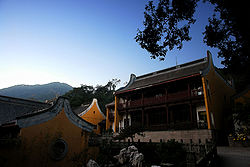
Zen
Zen is a school of Mahāyāna Buddhism founded by the Buddhist monk Bodhidharma. The word Zen is from the Japanese pronunciation of the Chinese word Chán , which in turn is derived from the Sanskrit word dhyāna, which can be approximately translated as "meditation" or "meditative state."Zen...
sect located north-west of Hangzhou
Hangzhou
Hangzhou , formerly transliterated as Hangchow, is the capital and largest city of Zhejiang Province in Eastern China. Governed as a sub-provincial city, and as of 2010, its entire administrative division or prefecture had a registered population of 8.7 million people...
, Zhejiang Province, People's Republic of China. The temple's name is commonly literally translated as Temple of the Soul's Retreat. It is one of the largest and wealthiest Buddhist temples in China, and contains numerous pagodas and Budddhist grottoes.
The monastery is the largest of several temples in the Wulin Mountains (武林山), which also features a large number of grottos and religious rock carvings, the most famous of which is the Feilai Feng (飞来峰; literally "the peak that flew hither").
History
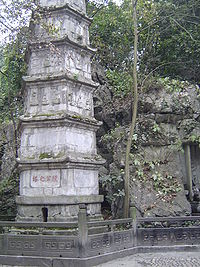
Hui Li
Hui Li was an Indian Buddhist monk who visited China in the 4th c. He is the founder of the Lingyin temple . The name is also written Huili....
, who came from India. From its inception, Lingyin was a famous monastery in the Jiangnan
Jiangnan
Jiangnan or Jiang Nan is a geographic area in China referring to lands immediately to the south of the lower reaches of the Yangtze River, including the southern part of the Yangtze Delta...
region. At its peak under the Kingdom of Wuyue
Wuyue
Kingdom of Wuyue , 907-978, was a small independent coastal kingdom founded during the Five Dynasties and Ten Kingdoms of Chinese history. It was ruled by the Qian family, which remains widespread in the kingdom's former territory.-Founding:...
(907-978), the temple boasted nine multi-storey buildings, 18 pavilions, 72 halls, more than 1300 dormitory rooms, inhabited by more than 3000 monks. Many of the rich Buddhist carvings in the Feilai Feng grottos and surrounding mountains also date from this era.
During the latter Southern Song Dynasty, the monastery was regarded as one of the ten most important temples of the Chan sect in the Jiangnan
Jiangnan
Jiangnan or Jiang Nan is a geographic area in China referring to lands immediately to the south of the lower reaches of the Yangtze River, including the southern part of the Yangtze Delta...
region. However, its prominence has not saved the temple from marauders. It has been rebuilt no less than sixteen times since then. The current buildings are modern restorations of late Qing
Qing Dynasty
The Qing Dynasty was the last dynasty of China, ruling from 1644 to 1912 with a brief, abortive restoration in 1917. It was preceded by the Ming Dynasty and followed by the Republic of China....
buildings. During the Cultural Revolution
Cultural Revolution
The Great Proletarian Cultural Revolution, commonly known as the Cultural Revolution , was a socio-political movement that took place in the People's Republic of China from 1966 through 1976...
, the temple and grounds suffered some damage at the hands of Red Guards
Red Guards (China)
Red Guards were a mass movement of civilians, mostly students and other young people in the People's Republic of China , who were mobilized by Mao Zedong in 1966 and 1967, during the Cultural Revolution.-Origins:...
. However, they escaped large scale destruction partly because of the protection of Premier Zhou Enlai
Zhou Enlai
Zhou Enlai was the first Premier of the People's Republic of China, serving from October 1949 until his death in January 1976...
.
Today the temple is thriving as a destination for both pilgrims and tourists. It is regarded as one of the wealthiest monasteries in China, and regular pilgrims have included former paramount leader Deng Xiaoping
Deng Xiaoping
Deng Xiaoping was a Chinese politician, statesman, and diplomat. As leader of the Communist Party of China, Deng was a reformer who led China towards a market economy...
.
Surrounds
The Wuling Mountains area is a major centre of ChanZen
Zen is a school of Mahāyāna Buddhism founded by the Buddhist monk Bodhidharma. The word Zen is from the Japanese pronunciation of the Chinese word Chán , which in turn is derived from the Sanskrit word dhyāna, which can be approximately translated as "meditation" or "meditative state."Zen...
Buddhism
Buddhism
Buddhism is a religion and philosophy encompassing a variety of traditions, beliefs and practices, largely based on teachings attributed to Siddhartha Gautama, commonly known as the Buddha . The Buddha lived and taught in the northeastern Indian subcontinent some time between the 6th and 4th...
in south-eastern China
China
Chinese civilization may refer to:* China for more general discussion of the country.* Chinese culture* Greater China, the transnational community of ethnic Chinese.* History of China* Sinosphere, the area historically affected by Chinese culture...
. A number of smaller temples are also located in the area. Today, Lingyin and the surrounding areas are marketed as the Lingyin-Feilai Feng Scenic Area, with ticketed admission. Visitors enter from a screen wall marked with a four character inscription "the Western Heaven is within reach" . Proceeding down the road from the entrance, the visitor first sees Feilai Feng on the left, then Lingyin Hill on the right. The entire scenic area is dotted with historic buildings and artwork, including pagodas, pavilions, bridges, and statues. The largest stone pagoda is located near the entrance. Called Elder Li's Pagoda (理公塔), it houses the ashes of Hui Li
Hui Li
Hui Li was an Indian Buddhist monk who visited China in the 4th c. He is the founder of the Lingyin temple . The name is also written Huili....
, the India
India
India , officially the Republic of India , is a country in South Asia. It is the seventh-largest country by geographical area, the second-most populous country with over 1.2 billion people, and the most populous democracy in the world...
n monk who founded Lingyin.
The area is thickly wooded, with some trees labelled as many centuries old.
The Feilai Feng grottoes
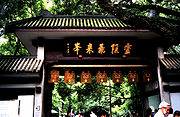
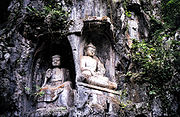
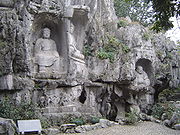
India
India , officially the Republic of India , is a country in South Asia. It is the seventh-largest country by geographical area, the second-most populous country with over 1.2 billion people, and the most populous democracy in the world...
(with some versions suggesting that it is Vulture Peak), but flew to Hangzhou
Hangzhou
Hangzhou , formerly transliterated as Hangchow, is the capital and largest city of Zhejiang Province in Eastern China. Governed as a sub-provincial city, and as of 2010, its entire administrative division or prefecture had a registered population of 8.7 million people...
overnight as a demonstration of the omnipotence of Buddhist law. A large number of carvings dot the surface of the peak. More are located in various caves and grottoes throughout the peak. Within the main cave, dedicated to the bodhisattva
Bodhisattva
In Buddhism, a bodhisattva is either an enlightened existence or an enlightenment-being or, given the variant Sanskrit spelling satva rather than sattva, "heroic-minded one for enlightenment ." The Pali term has sometimes been translated as "wisdom-being," although in modern publications, and...
Guanyin, there is a crack in the ceiling of the cave that stretches up to the surface, so that a person standing at a certain position can see a sliver of sunlight. This is known as the "one thread of heaven" (一线天).
Lingyin Temple
The main axis of Lingyin follows a traditional Song dynasty five-hall Chan sect structure. The main axis stretches up the Lingyin Hill. However, the five-hall axis is a recent recreation. Only the front three halls are a part of the Qing dynastyQing Dynasty
The Qing Dynasty was the last dynasty of China, ruling from 1644 to 1912 with a brief, abortive restoration in 1917. It was preceded by the Ming Dynasty and followed by the Republic of China....
axis.
Hall of the Heavenly Kings
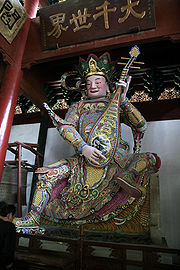

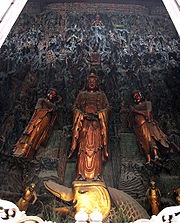
Four Heavenly Kings
In the Buddhist faith, the Four Heavenly Kings are four gods, each of whom watches over one cardinal direction of the world.The Kings are collectively named as follows:...
. This hall is a double-eaved building. The front of the building carries a plaque , written by the Kangxi Emperor
Kangxi Emperor
The Kangxi Emperor ; Manchu: elhe taifin hūwangdi ; Mongolian: Энх-Амгалан хаан, 4 May 1654 –20 December 1722) was the fourth emperor of the Qing Dynasty, the first to be born on Chinese soil south of the Pass and the second Qing emperor to rule over China proper, from 1661 to 1722.Kangxi's...
. The principal statue in this hall is that of the Maitreya
Maitreya
Maitreya , Metteyya , or Jampa , is foretold as a future Buddha of this world in Buddhist eschatology. In some Buddhist literature, such as the Amitabha Sutra and the Lotus Sutra, he or she is referred to as Ajita Bodhisattva.Maitreya is a bodhisattva who in the Buddhist tradition is to appear on...
Buddha in his manifestation as the cloth bag monk
Budăi
Budăi may refer to places in Romania:* Budăi, a village administered by Podu Iloaiei town, Iaşi County* Budăi, hill in the proximity of Călugăreni in Botoşani Countyand to several in Moldova:* Budăi, Taraclia, a commune in Taraclia district...
, or the Laughing Buddha. At the back, facing up the hill, is the Skanda
Skanda (Buddhism)
Skanda is a Mahayana bodhisattva regarded as a devoted guardian of Buddhist monasteries who guards the Buddhist teachings...
Buddha, or Weituo as he is known in Chinese. This statue dates from the Southern Song Dynasty. Arranged along the left and right are the Four Heavenly Kings
Four Heavenly Kings
In the Buddhist faith, the Four Heavenly Kings are four gods, each of whom watches over one cardinal direction of the world.The Kings are collectively named as follows:...
. The ceiling is ornately painted and decorated with phoenixes
Fenghuang
Fenghuang are mythological birds of East Asia that reign over all other birds. The males are called Feng and the females Huang. In modern times, however, such a distinction of gender is often no longer made and the Feng and Huang are blurred into a single feminine entity so that the bird can be...
and dragons
Chinese dragon
Chinese dragons are legendary creatures in Chinese mythology and folklore, with mythic counterparts among Japanese, Korean, Vietnamese, Bhutanese, Western and Turkic dragons. In Chinese art, dragons are typically portrayed as long, scaled, serpentine creatures with four legs...
.
Visitors to the temple are often impressed by the size and majesty of the entrance hall and its statues of the heavenly kings. Indeed, the hall of the Heavenly Kings at the Lingyin Temple is as large or larger than the main hall at many temples, reflecting its status as the centre of Buddhism in south-eastern China.
The Hall of the Heavenly Kings is the formal entrance to the temple. However, this entry has been closed in recent years, with visitors funneled instead through side doors, where separate ticket offices are set up for admission to the temple.
Grand Hall of the Great Sage
The second and principal hall is the MahaviraMahavira
Mahāvīra is the name most commonly used to refer to the Indian sage Vardhamāna who established what are today considered to be the central tenets of Jainism. According to Jain tradition, he was the 24th and the last Tirthankara. In Tamil, he is referred to as Arukaṉ or Arukadevan...
Hall, or the Grand Hall of the Great Sage . It is separated from the Hall of the Heavenly Kings by a large courtyard, featuring a raised lawn bordered with trees. To the left of the courtyard stands the Hall of the Five Hundred Arhats. The Grand Hall of the Great Sage is triple eaved and stands 33.6 metres tall. It houses, as is traditional, a statue of Shakyamuni, the historical Buddha
Gautama Buddha
Siddhārtha Gautama was a spiritual teacher from the Indian subcontinent, on whose teachings Buddhism was founded. In most Buddhist traditions, he is regarded as the Supreme Buddha Siddhārtha Gautama (Sanskrit: सिद्धार्थ गौतम; Pali: Siddhattha Gotama) was a spiritual teacher from the Indian...
. The present statue was carved in 1956 from camphor
Camphor
Camphor is a waxy, white or transparent solid with a strong, aromatic odor. It is a terpenoid with the chemical formula C10H16O. It is found in wood of the camphor laurel , a large evergreen tree found in Asia and also of Dryobalanops aromatica, a giant of the Bornean forests...
wood in Tang Dynasty
Tang Dynasty
The Tang Dynasty was an imperial dynasty of China preceded by the Sui Dynasty and followed by the Five Dynasties and Ten Kingdoms Period. It was founded by the Li family, who seized power during the decline and collapse of the Sui Empire...
style and coated with 60 tael
Tael
Tael can refer to any one of several weight measures of the Far East. Most commonly, it refers to the Chinese tael, a part of the Chinese system of weights and currency....
s of gold. It is the largest wooden Buddhist statue in China. At the back of the main statue is a statue of Guanyin, backed by a large screen that features the carved images of some 150 Buddhist personalities, including the pilgrims of the Journey to the West
Journey to the West
Journey to the West is one of the Four Great Classical Novels of Chinese literature. It was written by Wu Cheng'en in the 16th century. In English-speaking countries, the tale is also often known simply as Monkey. This was one title used for a popular, abridged translation by Arthur Waley...
, Daoji
Daoji
Daoji , commonly known as Ji Gong or , was a Chán Buddhist monk of the Southern Song Dynasty in China. He was born with the name of Li Xiuyuan. . Some sources have cited his name as Lǐ Xiūyuán...
, and arhats. Arranged along the sides of the hall are images of the 18 principal arhats, and other prominent Buddhists. The interior of the hall reaches about 30 metres, with a gold-painted ceiling featuring base relief images of traditional Buddhist symbols.
Hall of the Medicine Buddha
Further uphill and behind the main hall is the Hall of the Medicine Buddha , housing a statue of the BhaisajyaguruBhaisajyaguru
Bhaiṣajyaguru , formally Bhaiṣajyaguruvaidūryaprabharāja , is the buddha of healing and medicine in Mahāyāna Buddhism. Commonly referred to as the "Medicine Buddha", he is described as a doctor who cures suffering using the medicine of his teachings.-Origin:...
Buddha, commonly called the Medicine Buddha.
Sutra Library
Uphill from the Hall of the Medicine Buddha is the Sutra Library . This, and the Huayan Hall behind it, were built from 2000 to 2002 to re-create the five-hall main axis. The Sutra Library does not house a major statue and is not open for worship.Huayan Hall
The fifth and last hall on the main axis is the Avatamsaka Hall, or Huayan Hall . Also built in 2002, this hall houses statues of the three sages of the Avatamsaka Sutra, known as the Huayan Sutra in ChineseChinese language
The Chinese language is a language or language family consisting of varieties which are mutually intelligible to varying degrees. Originally the indigenous languages spoken by the Han Chinese in China, it forms one of the branches of Sino-Tibetan family of languages...
- Shakyamuni, Manjusri
Manjusri
Mañjuśrī is a bodhisattva associated with transcendent wisdom in Mahāyāna Buddhism. In Esoteric Buddhism he is also taken as a meditational deity. The Sanskrit name Mañjuśrī can be translated as "Gentle Glory"...
, and Samantabhadra
Samantabhadra
Samantabhadra , is a bodhisattva in Mahayana Buddhism associated with Buddhist practice and meditation. Together with Shakyamuni Buddha and fellow bodhisattva Manjusri he forms the Shakyamuni trinity in Buddhism...
.
Hall of the Five Hundred Arhats
The Hall of Five Hundred Arhats , also a modern addition, faces onto the western side of the court yard in front of the main hall. The building has a complex floor plan, shaped like a Buddhist swastikaSwastika
The swastika is an equilateral cross with its arms bent at right angles, in either right-facing form in counter clock motion or its mirrored left-facing form in clock motion. Earliest archaeological evidence of swastika-shaped ornaments dates back to the Indus Valley Civilization of Ancient...
. Along the arms of the swastika are arranged the five hundred arhats as slightly larger-than-life bronze statues. Each statue is seated on a unique ornate seat. At the centre, where the arms of the swastika join, stands a bronze canopy housing statues of four bodhisattvas representing the four cardinal directions. This is currently the tallest solid bronze structure in the world.
Famous people from Ling Yin Temple
- DaojiDaojiDaoji , commonly known as Ji Gong or , was a Chán Buddhist monk of the Southern Song Dynasty in China. He was born with the name of Li Xiuyuan. . Some sources have cited his name as Lǐ Xiūyuán...
- A Buddhist monk who has attained folk hero status. - Dachuan Lingyin Puji (1179–1253)- compiler of the Wudeng Huiyan (Compendium of Five Lamps)

